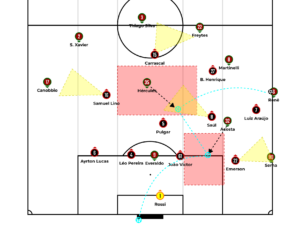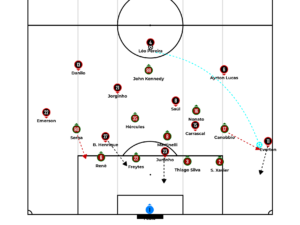Fluminense – Flamengo: Dua Lipa’s support bring luck to Fluminense, who deliver a tactical masterclass against their rivals (2-1)
Matchday 34 of the Brasileirão was on fire, filled with games packed with emotion until the final whistle. One of the rivalry classics, decisive for the top of the table, was the clash between Fluminense and Flamengo at Maracanã, with Dua Lipa’s fans in attendance. Flamengo did not take advantage of yet another slip from Palmeiras. They remain leaders, but lost to Fluminense at a crucial tactical point: concentration.
Tactical analysis and match report by Marcus Arboés.
Without needing to loan several players to the national team and with few absences, Fluminense arrived for the clash almost at full strength. Zubeldía once again lined up his team in a 4-2-3-1 formation. The legendary goalkeeper Fábio, who holds the world record for most matches played, started in goal. In defense, Samuel Xavier, the legend Thiago Silva, Freytes, and Renê. The midfield was composed of Martinelli, Hércules (the one who scored a decisive goal in the FIFA Club World Cup), and the star Lucho Acosta (former Cincinnati). Kevin Serna (Colombia National Team) played on the left wing, Canobbio (former Uruguay National Team) on the right wing, and Everaldo as a target man.
On Filipe Luis’s side, the FIFA break and several physical problems plagued the lineup, especially striker Pedro, who is out even for the Libertadores final. Thus, the team took the field in a 4-2-3-1 outline: Rossi in goal; Emerson Royal (former Milan), João Vitor, Léo Pereira, and Ayrton Lucas (former Fluminense and Spartak) in defense; Saúl (former Atleti) and Pulgar (former Chile National Team) as holding midfielders; Luiz Araújo (former Lille) on the right, Samuel Lino (also former Atleti) on the left wing, Carrascal (Colombia National Team) in the middle, and Bruno Henrique as striker.
Zubeldía’s defensive masterclass
The first half was a Fluminense spectacle in tactical, strategic, and disciplinary terms, including the atmosphere created by the fans. It could have been three or four goals, because Zubeldía’s strategy completely shut down the opponent and was executed at a very high level. The concentration of his players and their focus in every duel validated the goals that brought the win to the tricolor.

Fluminense’s defensive pattern in a 4-4-2 or 4-5-1 formation, protecting the center of the pitch against Flamengo attacking in a 3-2-5 positional shape.
Flamengo clearly had more ball possession and exchanged more passes in the opponent’s half. That is their pattern. That is how they impose themselves against opponents. But just like against Santos, they faced a team that knew how to defend with discipline in a low block, protecting the inside spaces. Filipe Luis’s team attacked in a 3-2-5 shape, occupying zones based on positions within the tactical system to find different types of advantages for their players. Inside spaces, the team always finds excellent solutions, so it is essential to protect interior zones. Even so, their best passes in the first half were progressive balls through the central channel.
Just like Vojvoda did on Matchday 33, setting up a 4-5-1 shape with a block of five players closing zonal space in a 3-2 shape, Fluminense did something similar, but marking more individually in a 4-4-2 formation that shifted into a 4-5-1 or 5-4-1 when winger Kevin Serna tracked the runs of fullback Emerson Royal. This way, the home team always had numbers inside, winning several duels through physical imposition, while the width of the field was protected in a very coordinated manner.
In this tactical scenario, Flamengo tried to attack with wide triangles, prioritizing Samuel Lino’s individual play on the left or Emerson Royal’s crosses on the right. In any case, Freytes, Renê, Thiago Silva, Samuel Xavier, and goalkeeper Fábio protected the box effectively, preventing the opponent from creating clear chances in the first half, while Fluminense’s offensive transitions generated significant danger.
The plan was perfect. It targeted the weaknesses of Flamengo’s strong team, but the goals did not come directly from that. Still, this structure guaranteed an important advantage for Fluminense to sustain Flamengo’s first defeat against a rival this season.
Throw-ins also win games
In a moment in football where set pieces become increasingly decisive, it is important to have strategies both to attack and defend throw-ins. Fluminense scored twice, one of them indirectly after a throw-in, where the focus and positioning of the players, especially Serna, were key to exploiting a poor back pass by João Vitor and a ridiculous control error by Rossi. The other was a tactical masterpiece from a throw-in.

Throw-in sequence that led to Fluminense’s first goal, exploiting Flamengo’s attention triggers to generate spaces and individual vulnerabilities.
It is very common for teams to crowd the area around a throw-in, with players coming close to try to win aerial duels, while the defending team tries to suffocate those movements. Fluminense did not do that. They remained more spread out. The idea was precisely to generate spaces and divide the attention of the opposing players.
Look at the image above to understand how Fluminense planned Lucho Acosta’s brilliant goal: on the far side, Canobbio holds position in width to divide Samuel Lino’s attention; inside, Hércules positions himself behind the first line, which splits between marking the center backs and Martinelli. He uses that gap and Pulgar’s distance, who tends to protect the edge of the box, to free himself and receive Renê’s throw.
In the broadcast with images, Filipe Luis even notices and points it out, but it was already too late. Hércules controls, drives forward attracting the marker, and delivers the pass. The second detail lies in the ball-carrying that pulls pressure and frees Acosta, because there are also attention triggers there: Samuel Lino, Carrascal, and Pulgar are already too far from the play. Saúl, who was marking Lucho Acosta, immediately shifts his focus and creates a gap behind him that could have been covered by two players.
Emerson Royal was marking Kevin Serna, who moved inside and deeper in the corridor where the play started. When Emerson tried to cover, it was too late. This was the same type of gap that Sport exploited in the previous round, taking advantage of the expected insecurity of the young João Vitor, who is still not accustomed to the quick stimuli of professional-level football. Acosta took advantage of that split second and finished first-time, catching Rossi slightly off his line.
After that, the already explained Kevin Serna goal happened. João Vitor made the correct decision to play the back pass, but Rossi was extremely reckless by not checking who was pressing him and by touching the ball three times before miscontrolling it and gifting it to Serna. The Fluminense crowd erupted, and Dua Lipa was delighted.
Éverton Cebolinha’s second half
Fluminense could have scored more goals in the first half and deserved the win because of their game plan execution. But it is undeniable that Flamengo grew in volume during the second half, and that was due to a specific player who felt the weight of the rivalry and has been pushing for a starting role, which must be creating doubts in the coach’s mind.

Flamengo’s positional attack in a 3-2-5 shape with Éverton Cebolinha providing width, now against Fluminense protecting themselves in a 4-5-1 or 5-4-1 outline, with Canobbio doubling the marking on the last line.
If the center of the pitch was completely blocked, Filipe needed his team to attack wide. And if they were not winning aerial duels, they needed more volume of crosses and a player who could create confusion inside the box defended by Fábio. So he made three changes: Juninho (former Qarabag) entered as target man; Danilo (former Juventus), who is excellent at frontal crosses and returned from Brazil National Team friendlies, replaced João Vitor, who was nervous; Éverton Cebolinha (former Benfica) came in on the left wing to generate more uncertainty in the opposing defense than Samuel Lino.
This worked in terms of game plan. Flamengo increased their volume of crosses into the area. Fluminense had to make adjustments, bringing on Nonato and John Kennedy. Cebolinha was heavily involved and looked like the team’s ace. To deal with this, Fluminense inverted the winger who dropped back on the last line to double the marking. Canobbio started confronting Cebolinha first, with Samuel Xavier covering. Even so, the Flamengo attacker generated several dangerous situations.
It was from one of these plays that Flamengo earned the cross that led to the penalty committed by Renê, which Jorginho (former Arsenal and Chelsea) converted to make it 2-1. Other dangerous chances came, and Fluminense also had strong counterattacks, but nothing enough for Flamengo to equalize, even though there was controversy about a penalty not given when it was still 2-0. On the pitch, Zubeldía’s Fluminense and Dua Lipa deserved the win.
Takeaways
Fluminense is increasingly close to securing at least a spot in the 2026 Libertadores preliminary phase, recovering well after the elimination to Lanús in the Copa Sudamericana. With the win against their biggest rival, Zubeldía’s team remains undefeated at Maracanã, beating everyone and showing incredible focus. Since Bahia lost, Fluminense climbed one spot in the table and, after beating the league leaders, will face second-place Palmeiras in the next round.
Palmeiras drew and slipped for the second straight time, but this time reduced the gap to Flamengo. If Filipe Luis’s team had won, it would have been a major leap toward the title, opening a five-point advantage after defeating their rival, bringing even more confidence to the squad. But the defeat shortened the distance instead. To fix this, they need to beat Red Bull Bragantino tomorrow and hope for help from their rival Fluminense to disrupt Palmeiras’s plans.
Use the arrows to scroll through all available match plots. Click to enlarge. Check the match plots page for plots of other matches.




Comments